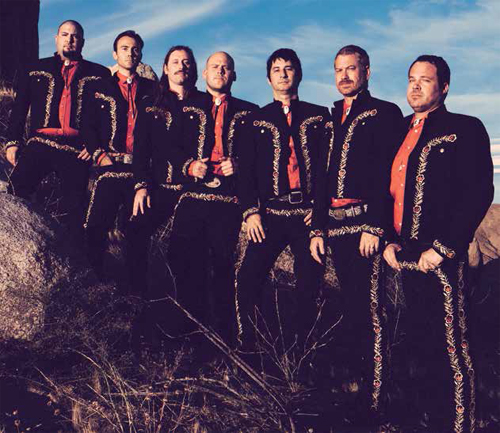Spotlight: Mariachi El Bronx

“There is a road in my life and—although things happened unexpectedly—you could look back, and you could map out how it all happened,” Mariachi El Bronx singer Matt Caughthran says, sitting outside Los Angeles’ El Rey Theatre before his group’s album release show in November. “I grew up a metal kid and, sooner or later, I discovered punk and got into smoking cigarettes and drinking and skateboarding and everyone picked up an instrument but me. So it was only a matter of time before I would pick up a microphone and sing in a punk band. You could see how that could line up.”
He stops for a moment, considering, then adds, “With the El Bronx thing, it was the purest form of inspiration—where you find yourself in a situation that you never, in a million years, thought you were going to be in.”
But the fittingly named Mariachi El Bronx group is now cemented as part of that road through Caughthran’s life. The alter-ego project started as Los Angeles hardcore band The Bronx’s one-off attempt to create a mariachi album in 2009. The group, which also includes guitarists Joby Ford and Ken Horne, bassist Brad Magers and drummer Jorma Vik, released a second self-titled El Bronx record in 2011 and recently unveiled their eponymous third Mariachi El Bronx album in November—even as the musicians still aren’t totally clear on how it evolved from an experiment to a full-fledged band that exists separately from The Bronx.
The creative momentum of engaging with a new genre drove those first two back-to-back Mariachi El Bronx recordings, but before this third go-around, the band swung back to their hardcore sound for The Bronx’s fourth album last year. It was a notably extreme shift in stylistic tone after two groovy mariachi releases and, for Caughthran, it meant learning how to glide back and forth between the two aesthetics.
“I really didn’t want to write a mariachi record,” he admits. “I wasn’t really feeling it, and I was kind of fighting it mentally. So songs kept adding up and adding up. On top of it, there was personal stuff I knew was going to come out in the writing. I did not want to dive into it. I did not want to write a record right then. I was in a very aggressive mind-set and I didn’t know how to translate that into the songs I was getting. Finally, it was like, ‘OK, you’ve got to do something.’”
Going into the third El Bronx record, the musicians specifically discussed opening up the musical boundaries of the genre and bringing in rock-and-roll song structures and more electronics. They wanted to make sure they weren’t laying down the same ideas over and over again, which is part of the reason El Bronx exists in the first place. “There were a lot of stumbling blocks, a lot of songs that didn’t make it,” Caughthran says. “It took a bit to get going, but once we got it going, everything was awesome.”
El Bronx recorded the album at Haunted Hollow in Charlottesville, Va., with producer John Avila, using their connections at ATO Records and Red Light Management to gain access to the Dave Matthews-owned studio. They stayed for two weeks and incorporated new instruments like harp, accordion and marimbas in the orchestration. The lyrics reflect a darker sensibility than the band’s earlier records, partially because Caughthran was grappling with the death of his father and their difficult relationship.
“It sucks because you’re always the last one to see it when you’re an asshole,” he says. “There is this weird thing that happens when you write demos—you write these heavy, dark or just super personal lyrics in this zone. And then sometimes months pass before you get to the point where you’re recording. You’re kind of like, ‘Fuck, I don’t want to go back to this headspace that I was in when I wrote this.’ It’s just like reopening a wound. You’re constantly in this state of emotional exhaustion.”
The resulting album is markedly sincere—a sensibility that has always defined the work of this particular group of musicians regardless of their chosen genre. They also looked at El Bronx as a new channel for the release of experiences rather than a gimmick. Its creation effectively changed their narrative and ensured that The Bronx was never going to be stuffed into a box along with their peers in the punk-rock scene.
“It was purely personal,” Caughthran says of El Bronx. “We were suffering creatively. And then, when it turned out good, it was like, ‘This could be something that takes us out.’ I thought about all the bands we could play with, all the tours we could do—this was going to be the thing that could break us out.”
However, he’s still not sure which roads his projects will take. “I don’t know specifically what we’re going to do,” the singer says. “We always talk about how the bands are separate, and we love that sonically. But we want to find a way to pair them. The cool thing is we have these two different, awesome bands that we love, so now it’s about how we can do cool things with them.”



















